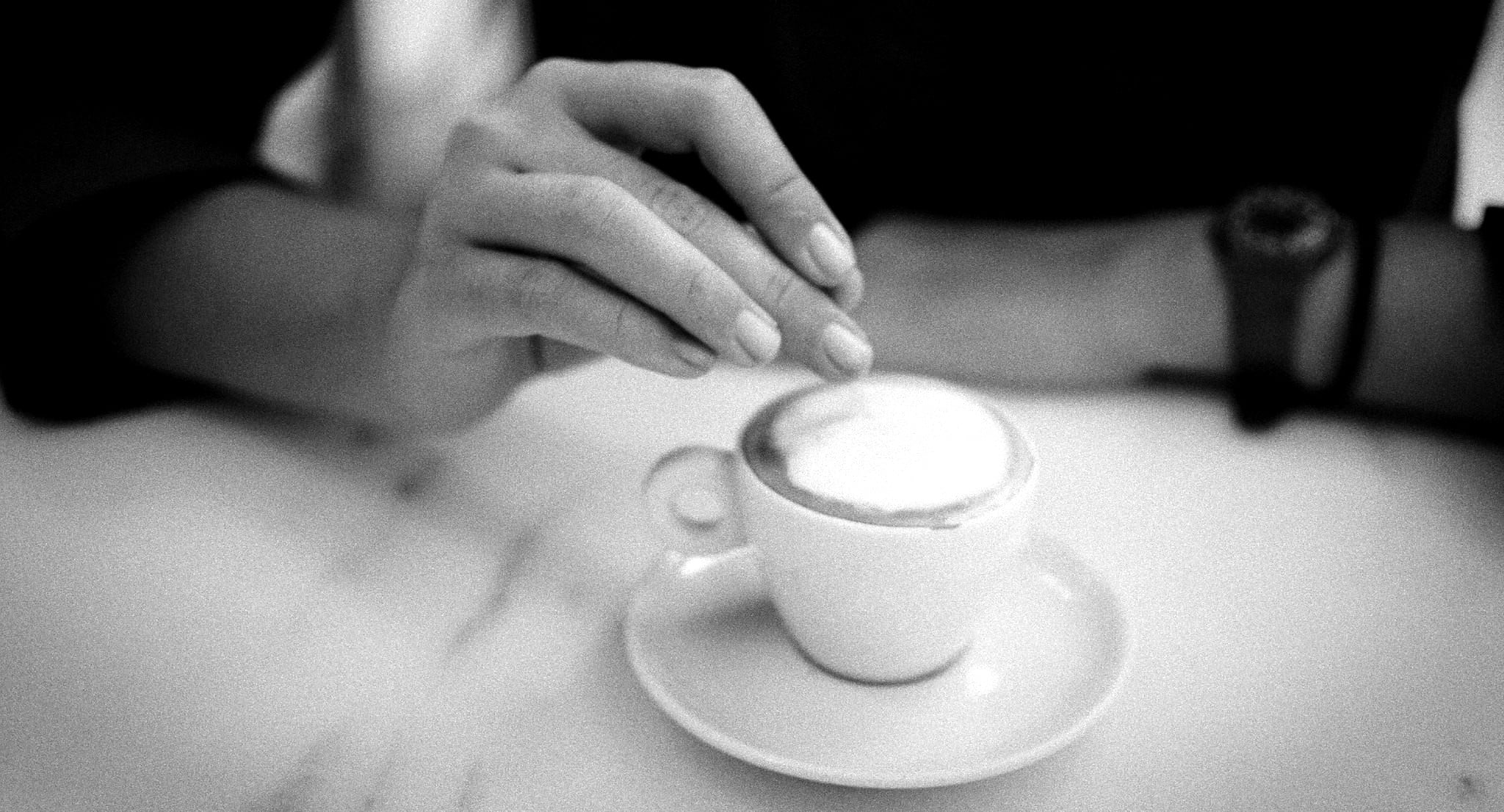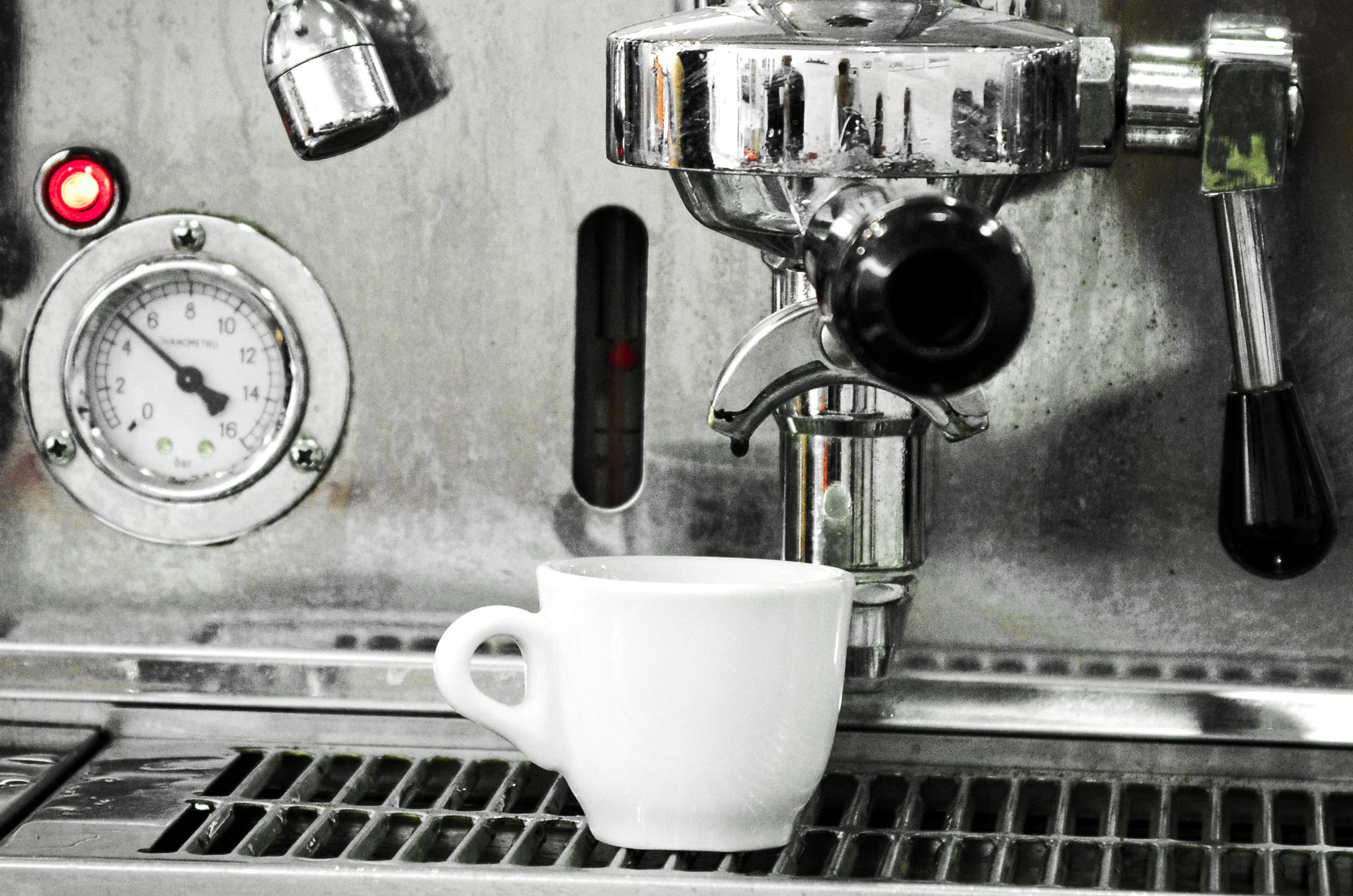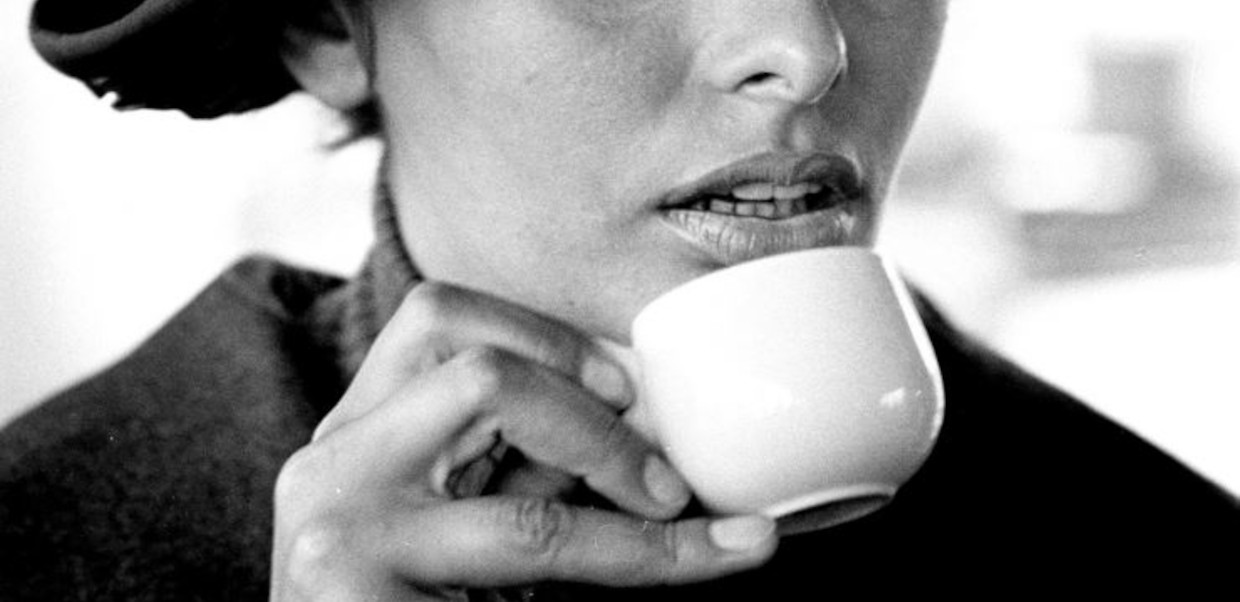History, heritage, culture, conviviality, palate
Coffee is much more than just a drink in Italy. For us it’s a real cult, a tradition known all over the world that inspires values of conviviality, sociality and hospitality. Discover the ritual and sociability of Italian Coffee culture at the bar.
Espresso isn’t a specific type of Italian coffee, it’s an efficient and concentrated brewing method that can be used on any type of coffee bean. This Italian coffeemakers completely changed the way people enjoy coffee around the globe. The reason Italy is thought to be one of the coffee hot-spots of the world is the fact that – the espresso machine and coffee grinder – the Moka and Napoletana – have been invented and perfected here.
Also because Italian roasters and baristas are masterful with their techniques. From the elegant historic coffee house, called caffé, to the neighborhood coffee shop, the Italian bar – they all have a unique flair in Italy.
In this Article
The Italian language uses different words to emphasize the socio-cultural relationship with coffee.

Caffé pronounced as kaf-feh, is coffee, espresso coffee, not café, as in the place you’d go to get a coffee, but that’s not what we call coffee shops. Italians go to a bar to have an espresso, a cappuccino and a chat.
At home traditionally we use the Moka, the Napoletana and nowadays semi-professional espresso machines, home espresso makers with pods or capsule and other fancy coffee brewing devices. Coffee is traditionally served in a tazzina ta-ZZ-EE-naa, a tiny moka or espresso cup.
Just holding a warm cup of coffee provides many with a sense of comfort – especially when cradling porcelain or glass.
The indispensable Italian ritual of espresso or cappuccino at the bar
Espresso, that we call simply caffé in Italy (spelled café elsewhere in Europe), can evoke the coziness of home or the vibrancy of a bustling market square. In sidewalk cafés, pubs, sport bars, smoky subterranean clubs, taverns, fine restaurants, hotel lounges, historic coffeehouses, dining rooms, coffee shops and kitchens – People enjoy their coffee – either black or with varying amounts of milk (cappuccino), whipped cream, spices, sugar, or alcohol.
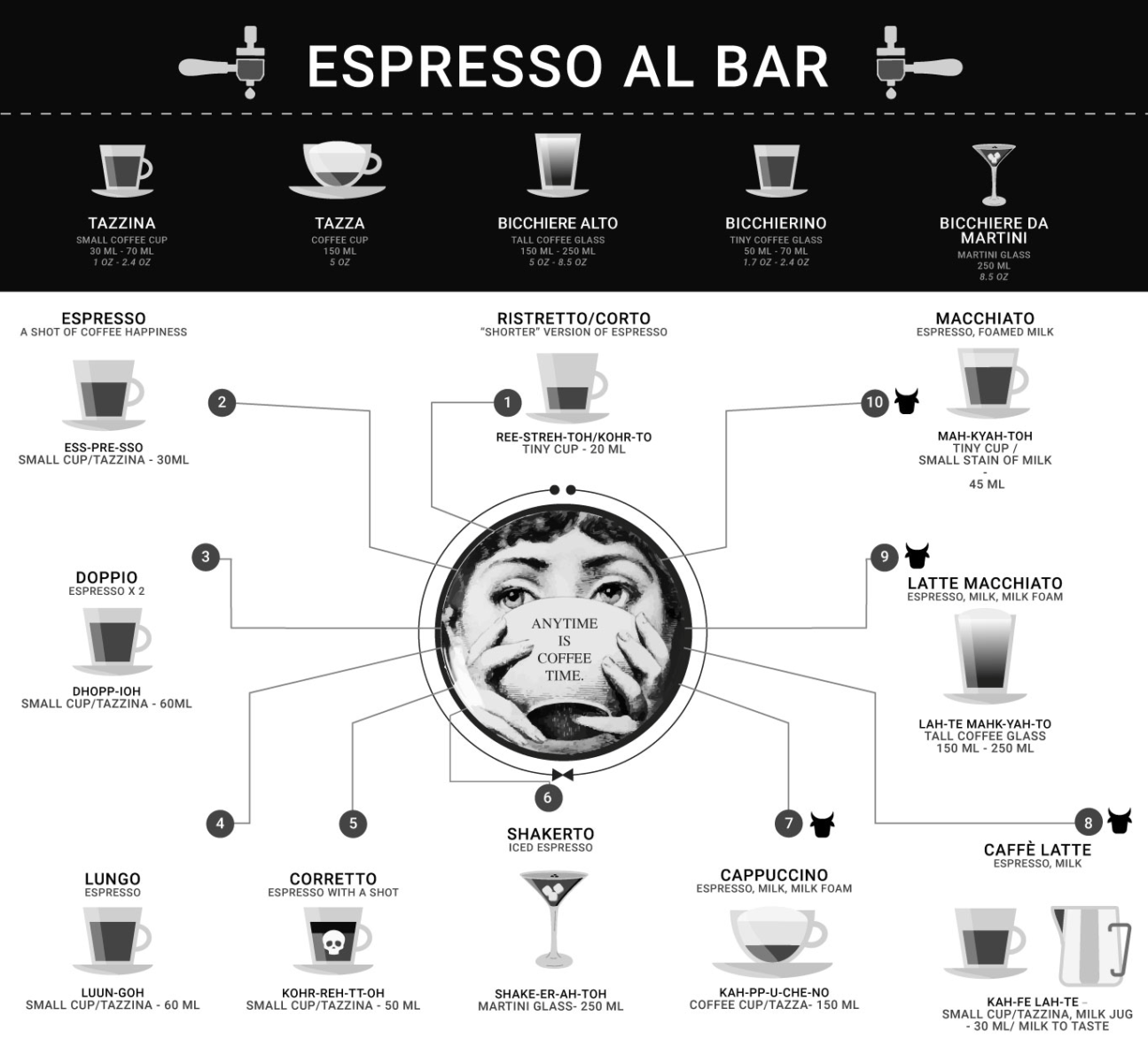
From Brennero to Lampedusa, we Italians frequent our favorite bar to read the news, play games, chat, exchange opinions and ideas, or simply observe life over the rim of a coffee cup.
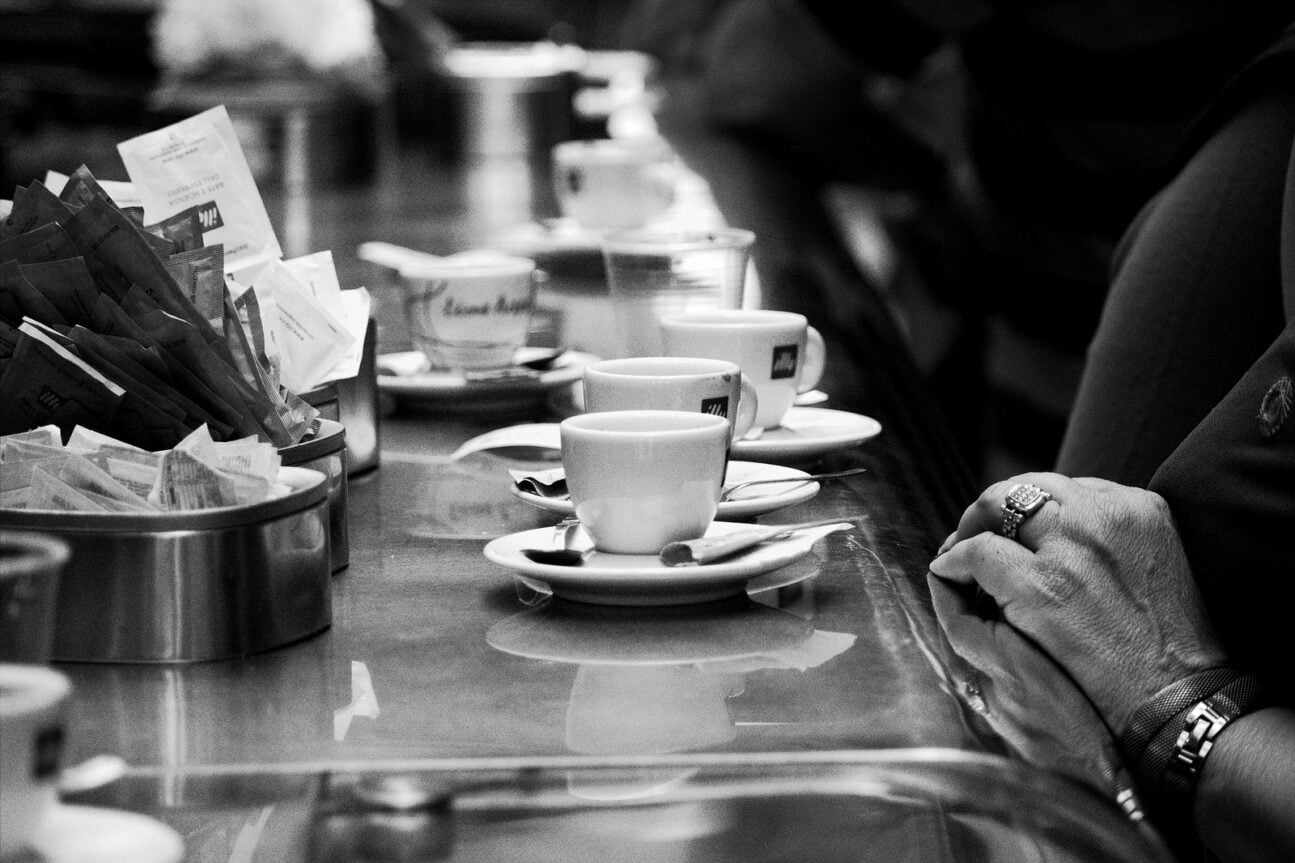
Italian Coffee Culture: SIT SIP SAVOR CHAT
Vorrei entrare dentro i fili di una radio
E volare sopra i tetti delle città
Incontrare le espressioni dialettali
Mescolarmi con l’odore del caffè
Fermarmi sul naso dei vecchi mentre Leggono i giornali
E con la polvere dei sogni volare e volare
Al fresco delle stelle, anche più in là
Le rondini – Lucio Dalla
I would like to enter the wires of a radio
And fly over the roofs of cities
Meet dialectal expressions
Blend in with the smell of coffee
Rest on the noses of old people while they read newspapers
And fly; fly with the dust of dreams
Into the freshness of the stars, and even further
The Swallows – Lucio Dalla
Italian coffee heritage
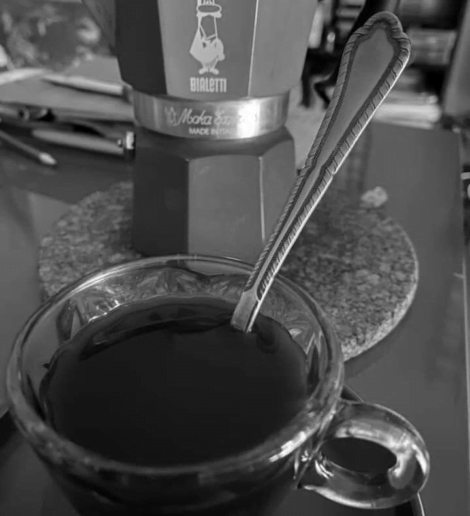
We take coffee seriously: Italian coffee tradition has grown to a veritable art form and developed a whole system of rituals and behaviors about caffè and its preparations. Moka coffee, Neapolitan cuccumella coffee, cappuccino and espresso, are not simple caffeine, but an essential daily ritual and veritable institution that have become part of our identity, recognized and appreciated throughout the world. The Tazzina, the small, elegant espresso cup and saucer, is widely perceived as the quintessential coffee vessel.
A shot of dark, velvety coffee is more than just a quick caffeine hit:
Italy’s espresso is a prized, a social and cultural ritual, part of our Italian heritage.
Despite Italy being the home of espresso coffee, we don’t grow the coffee plant (yet!). The idea that coffee is Italian, does seem quite bizarre. We’re not even close to being the biggest coffee consuming country: our per capita consumption is only about half of that of some northern European countries like Sweden or Finland.
There are many other countries worldwide far better known for specialty coffees than ours, such as Turkey, the US, Australia, Austria and Germany. And the coffee growing countries, like Colombia, Jamaica, Ethiopia, Vietnam, India and Brazil.
Caffè a Voyage of the Senses

Coffee has become popular as a local and global beverage in part because people see coffee as “our own.” It becomes meaningful for many reasons, which include the attachments or fondness that we develop for the ways that coffee is prepared and served, the places or contexts in which we consume coffee, and the ideas and feelings associated with drinking it.
As we embrace the aromas of coffee, we’re reminded that every cup, every bean, and every fragrance is a testament to the beauty of the sensory world we inhabit – a world enriched by the magic of aromas that have the power to transport us, awaken memories, and stir emotions.
Espresso conviviality – the thriving social life of the Italian Bar

The 3 Cs of Coffee –
Coffee is an essential part of everyday life in Italy and coffee consumption a historic, time-honored ritual. It’s one that Italians are proud of and attached to. There are about 150,000 “bars” in Italy (149.154 according to data of FIPE, the Italian Federation of Public Exercises) , this shows the deep fondness we Italians possess for coffee, a shared, a magical moment, coffee at the table is drunk according to the 3 Cs –
Caldo, Comodo e in Compagnia –
Hot, Comfortable and in Company
The Neapolitan 4 Cs
Espresso coffee at the bar in the south of the Peninsula, should certainly be drunk piping hot, or rather scorching, strong and sitting comfortably at the table in complete relaxation and in company.
Cocente, Carico, Comodo e in Compagnia –
Ardent, Loaded, Comfortable, and in Company.
That of the strongness (carico), would even be a fourth C, meaning loaded. In general, the farther south one travels in Italy, the greater the proportion of robusta in the blend. Robusta drinkers look for the element of smokey, slightly bitter caramel, which is the natural coffee sugars being caramelized in the high heat of a dark roast.
This probably accounts for the habit of adding sugar as standard practice, to the point that baristas often spoon it in automatically – and to serving espresso as a ristretto, at around 15 ml, thereby reducing the caffeine content. Like this – says Neapolitan tradition – the tazzulella (the espresso cup) manages to convey that extra energy to face the rest of the day.
Another Neapolitan saying (also with 3Cs) goes with it:
Cumme Cazzo Coce –
(drink while it is) damn hot
Pronounced Ku-MM-e KATS-TSO KOO-CHE. In order to avoid profanities, “cazzo” is a favorite swear word in Italian, this euphemisms “cumme caspita coce”, mamma mia quanto brucia – Oh, its scalding hot! – Would also work.
In the North of Italy, espresso could be more delicate and thus with a higher percentage of Arabica, to create flavor notes that dominate with caramel, vanilla and nuts.
The bar ritual of conviviality – Prendiamo un caffè! Let’s get coffee
“…A bar is a place of long stops, like an English club; but it is also a place of fast passages, like a Chinese market. It’s the place where, while drinking an espresso, you decide on business or about how to pass the evening, about the beginning of a cooperation or the end of a love…” says Beppe Severgnini , in “La testa degli italiani”. 2005.
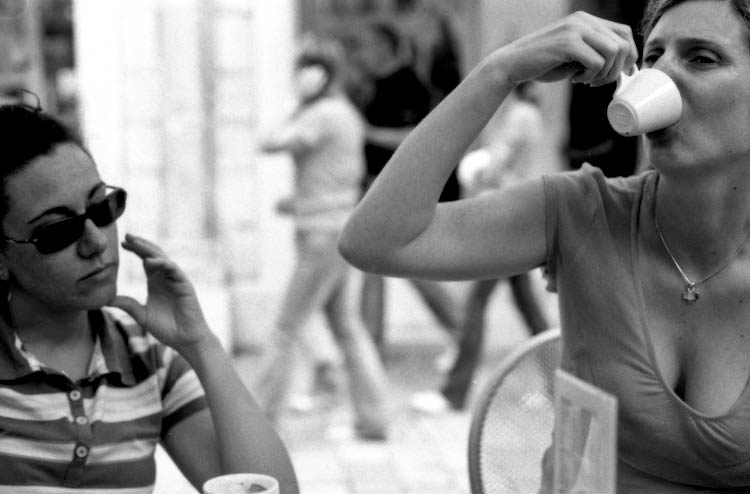
– Taking a coffee, un caffè is a daily ritual, the day cannot begin without having had the first coffee at breakfast, followed by that in the mid-break morning, after lunch, in the afternoon, and sometimes after dinner, as if to mark the various Times of Day.
“Giusto il tempo di un caffè” oppure “Prendo un caffè e arrivo”. “Just the time for a coffee” or “I take a coffee and I arrive” are recurring phrases in the Italian language referring to the timing of its fast and codified preparation and consumption pattern.
Some say they cannot avoid drinking coffee because it is an unavoidable habit after meals, a daily ritual. Italian life centers around coffee. 98% of us drink it – daily – at home, or al bar and often in company.
One of the most widespread reasons for drinking a tiny cup of coffee in Italy is certainly socialization. A bar offers the possibility and the space to be together, to mingle: And when we meet someone in the post office, on the street, in the squares and in the alleys, we invite them for coffee.
Andiamo a prenderci un caffè,–
Shall we have a coffee?
or
ti offro un caffè,–
I’ll offer you a cup of coffee,
No matter the time, no matter the day it is always the right time for friends or to socialize with a colleague while perking up with a caffè. Let’s have a coffee, can be equivalent to saying “good morning” to a friend. “Shall we have a coffee?” is a common way of saying “let’s spend some time together and exchange opinions and ideas.”
Actually inviting someone for coffee does not imply to drink an espresso, everything from water to fruit juice and – alcohol, can be drunk if you go for a coffee.
Coffee is a way to remind us that the pleasures of life are best shared. We love coffee because it accompanies our sociability. Here is the explanation of the secret of this Italian coffee ritual:
It is enjoyed because it is in front of a coffee that friendships, and romantic love stories are born or arguments about politics and daily struggles are made.
Italian conviviality and coffee
Entering the bar, looking out for a small table, the newspaper by hand, finding a comfortable seating position and the chatter starts naturally: the air is filled with advice, stories, laughter. We sip our espresso and talk about life and perhaps, why not, gossip! Reading the news together and chat about it, oh, what fun it is. The ritual of coffee is so intimate and yet so convivial.
Massimo Montanari in the book “Il riposo della polpetta” explains the simplicity of conviviality and coffee:
“…The five senses are like bridges along which mankind engages with the world, this is why in our language, we refer to them in a figurative way:
“to have an eye for something”, “to smell something out”, “to have tact”, “to have good ears” and “ to have taste”.
This expressions denote an ability to distinguish the good from the bad, the beautiful from the ugly. Someone is said to “have good taste” when they recognize the quality of what is being experienced, be it a cooked dish, a painting, a novel, a landscape, or an object!
I am thinking of convivial rituals. We are used to thinking of conviviality by opposing the holiday against the weekday, as a special event. The level of this discourse can be lowered without losing it, rather by transferring it to everyday life, conviviality still exists in simplicity. Making the most of coffee time with family and friends, for example, is an easy way to keep relationships, even of a sacred nature, linked to the consumption of coffee at a simple level. Let’s not forget, eating and drinking is a relational gesture…”
For an Italian, entering a “bar or caffé” for a coffee is ordinary, daily and almost ritualistic. We are passionate about “bars” since they serve as gathering places to catch up with friends and neighbors, discuss, read the newspaper, watch the football match or play cards all while enjoying a caffé, grappa, beer or wine.
The “bar” is a symbol of Italy and dolce vita associated with the pleasure of Italians to give yourself a coffee at any time of the day and night.
We (59 million Italians) sip some 30 million espressos a day, from Brennero to Sicily, in porcelain cups, la tazzina, or little glasses, al vetro, with or without a splash of milk or cream or alcohol – and we see each shared coffee as a gesture of friendship.
At home, coffee is synonymous with hospitality. When you visit someone’s house, an Italian will offer you a cup of coffee, freshly made with the Moka, Napoletana or home espresso machines. It is a way of opening one’s home to the guest, giving the guest the right amount of time, attention and trying to make the guest comfortable.
Coffee time is special: a unique, suspended, almost magical occasion. To say it with the words of Luciano De Crescenzo:
Have you ever wondered what coffee is?
Coffee is an excuse.
An excuse to tell a friend that you love him.
Il caffè sospeso or suspended coffee
The best part of coffee is sharing it, even if it’s with someone you don’t know.
Neapolitan saying

The finely decorated literary cafè, Cafè Gambrinus, is the birth place of the concept of the caffè sospeso (suspended coffee or pending coffee), a kind gesture that involves paying for a coffee and leaving it for the less fortunate.
People can pay for an extra coffee and put the receipt in a bronze pot. Later, someone in need can come in and use the receipt to get a free coffee.
The tradition of a free coffee paid forward, gave the title to a 2009 book by Neapolitan writer, director and actor Luciano De Crescenzo. Il caffe sospeso: Saggezza quotidiana in piccoli sorsi (Suspended coffee: Daily wisdom in small sips), which helped publicise the tradition throughout Italy. Daily wisdom in small sips was dedicated to what is not only a habit of the city of Vesuvius, but also a philosophy of life.
“When someone is happy in Naples, instead of paying a cup of coffee for himself, he just pays another one for someone else; it’s like offering a cup of coffee to the rest of the world.”
Luciano De Crescenzo
The tradition of the suspended coffee represents a simple, anonymous act of generosity towards humanity, and the kindness devolved to the people from a whole city. Nevertheless, this is not to be seen as an act of charity, but rather as the intention of sharing a pleasure.
Caffè al volo – Coffee on the fly
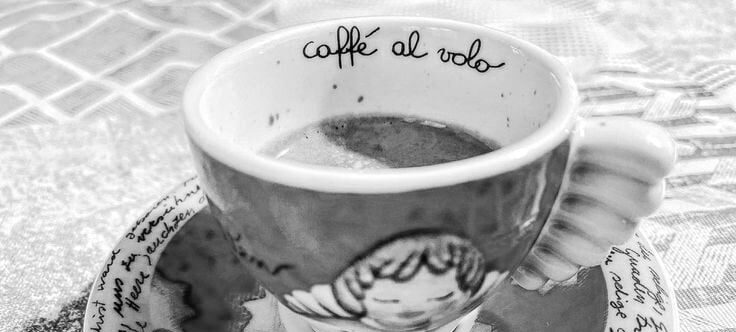
For a quick espresso, on the doorstep of the bar, I would say:
“Hey Gianni, un caffè, please. “
At the bar you will never ask for “un espresso” but simply “un caffè”. This would be, – “Un nero per favore” in Trieste or “na tazzulell e’ caffè” in Naples.
The sound of the burr grinder crushing the beans between two cast metal plates, the hissing and whistling of the machine – the steam. Pouring the extraction little by little until creating a crema, on top and here we are:
il caffè è servito – coffee is served!
Prendere un caffè al bancone (Standing at the counter), one elbow on the counter, a chat on the fly with frenetic light-heartedness, 2 or 3 sips, then replacing the cup on the saucer with the proper authoritative clack. Maybe a brioche or cornetto, “Ciao grazie, a domani. (Thank you, bye bye, see you tomorrow) and moving on with my day.
In bars and coffeehouses, the standing coffee costs less then a seated coffee. Sitting on outdoor tables overlooking an ancient square, a buzzing market or gazing along a peaceful coastline has it’s price. As well as quality coffee.

The way some bartenders have adopted to playfully establish social education that characterizes the life of a bar, during quick encounters between customer and barista is shown in this picture.
Here’s what it reads: a coffee 3 €, good morning a coffee 2 € and good morning a coffee please 1,50 €. A manifesto of bon-ton that just wants to make us reflect on how modern living makes us hasty and superficial in human relationships, even when faced with the convivial pleasure of an espresso. Ultimately, coffee etiquette is very simple: good morning, please and thank you!
In 1911,the Italian government enforced a maximum price for certain “necessities”, which included coffee. With the advert of the euro in Italy, most prices doubled, so coffee reached the cost of around an euro. Given these low prices, espresso bar operators sought to cut corners and save money in other places, including service. Many of them charged extra if the customer sat down to drink their espresso, rather than standing.
Service times in Italy for an espresso are just over 30 seconds on average. Traditionally, Italians drink espresso in no more than three sips. All of this helps keep customer turnover high maximizing bars’ profit margins.
The barista or barman – espresso coffee professional bartender
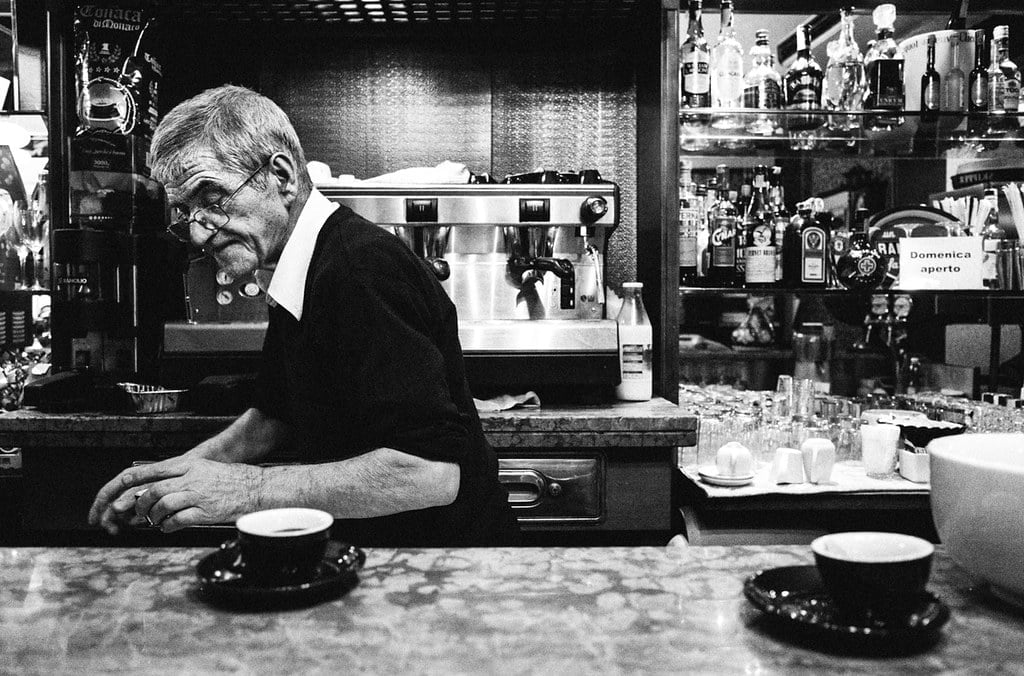
She, or he may be friendly or severe, some may be fatherly or motherly, but it is a serious profession, not something baristas do on the side. Indeed, the role of a barista is an important one in Italian every day life. The barman knows what you like – whether it is to drink quietly or to engage in conversation – and is someone you trust.
The “bar” plays a fundamental role in Italians’ life, sometimes the barista becomes a friend, a confidant and the place itself becomes a regular appointment, a moment of escape from every days struggle, a distraction.
The Barista is an Artisan, Coffee Connoisseur, and Cultural Ambassador
The professional barista is more than just a coffee maker in Italian coffee culture. They are skilled artisans who understand the nuances of coffee beans, the intricacies of espresso machines, and the delicate balance of flavors in each cup. A great barista is a master of their craft, able to create perfect espresso shots while engaging in friendly conversation with customers.
The Bartenders experience is crucial to a good cup of coffee.
Having a coffee in an Italian bar (in practice)
In busy bars you pay for your shot of espresso upfront and then present your receipt, the so called scontrino, to the bartender who will serve you in order of arrival.
Sugar is optional and largely dependent on the roast and the volume of bitterness in the coffee.
In most bars in Italy coffee is served amaro (bitter), without sugar. You will find the sugar bowl on the counter (banco) or individual sugar packets next to the tea/espresso spoon on the saucer.
In Naples coffee is often served dolce (sweet), sometimes even a sign “coffee is sweetened” welcomes customers; tell the barista if you want your O’ tazzulella (cup) without sugar.

As we Italians are known to be very demanding when it comes to our coffee. Some of us would order a caffè in vetro – a coffee served in a glass rather than in a porcelain cup – or might ask for some cold milk in it. These are only two among the countless requests coffee lovers can have.
The significant differences regarding taste and ways of consumption in the various areas of Italy, in particular between North and South, are closely linked to the culture, traditions and habits of the people who consume it.
When it is time to order, the variations on coffee are as many and different as there are people in front of the counter: extra short, short, long, double, tall, small cup, large cup, glass, decaffeinated, hot Macchiato, cold Macchiato, lukewarm, with milk on the side, with soy milk, corrected, Moroccan, American, with cream, with fly, and so on and on and on…
Cappuccino is usually drunk in the North of the Peninsula. We also drink cappuccino, the frothy milk with a shot of espresso, exclusively for breakfast, which sometimes happens late in the morning, very late. After lunch or dinner cappuccino is unpopular.
In the Italy of coffee, however, you just need to change town to find variations in color and aroma, taste and quantity in the cup.
Drinking an espresso or ristretto (20ml extraction) al bar is an act rigorously performed standing at the counter for a few quick minutes, moreover, drinking it while sitting on the inside generally increases the price of your shot.
Some bars will serve your coffee with a small glass of water. We drink this water before the coffee – as a palette cleanser to better enjoy the taste – rather than afterwards.
Regional coffee diversity in Italy
Lungo or ristretto, espresso, sweet or bitter, with or without sugar, in glass or tiny ceramic cup, and shaken with ice. While remaining a common ritual, coffee is deliciously diverse combined with regional flavours and Italian traditions from east to west and north to south along the Italian peninsula. Unique is, that every city and small town of the bel paese has their own local roaster, which is why espresso tastes different from region to region.
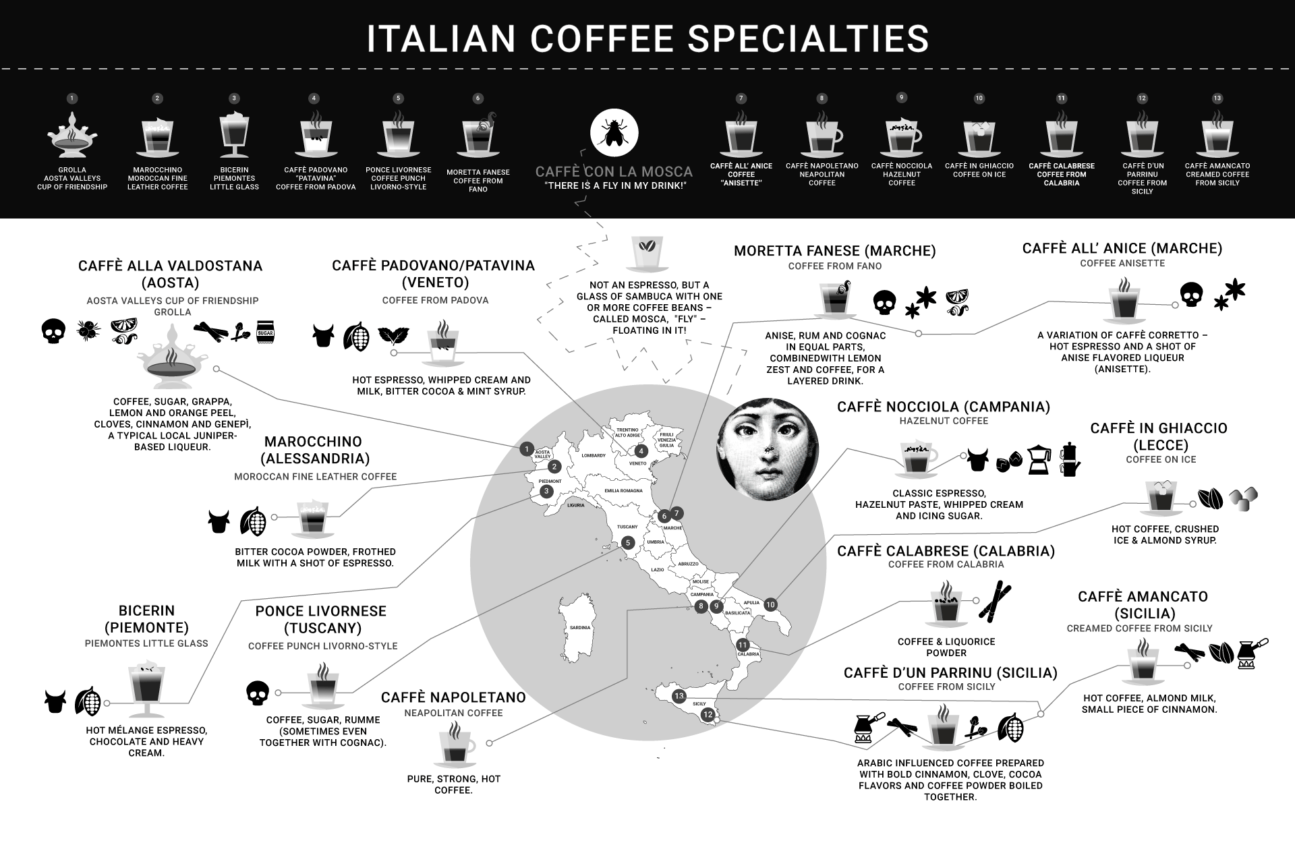
At all times of the day, caffè is imperative. You know that, as an Italian the shot of hot, strong fragrant coffee is something you are entitled to as many times a day as needed. It might sound like a lot of coffee, but caffè is only a tiny little cup of espresso. We love to sip our tazzina di caffè, and we would unlikely renounce to it.

The joy in that tiny cup of coffee is part of Italy’s appreciation of life’s small things.
~ ○ ~
Keep exploring:
Works Cited & Multimedia Sources
The history of coffee is an extraordinary study. If you would like to learn more about it, I heartily recommend the book, All About Coffee, by William Ukers. Written in 1928, it will delight you with detail.
- it.wikiquote.org (https://it.m.wikiquote.org/wiki/Voci_e_gridi_di_venditori_napoletani)
Voci e gridi di venditori napoletani - http://90905.homepagemodules.de/t155f59-Cappuccino-Kapuziner-Melange-oder-wie-jetzt.html
- https://en.wikipedia.org/wiki/Caff%C3%A8_sospeso
- Allegra World Coffee Portal www.worldcoffeeportal.com
- Artusi Pellegrino. Science in the Kitchen and the Art of Eating Well, transl. Murtha Baca and Stephen Sartarelli. 2003.
- Biderman Bob. A people’s history of coffee and cafés. 2013.
- Café Culture Magazine www.cafeculturemagazine.co.uk
- Carosello Bialetti: la caffettiera diventa mito https://www.famigliacristiana.it/video/carosello-bialetti-moka-mito.aspx
- Cociancich Maurizio. Storia dell’ espresso nell’Italia e nel mondo. 100% Espresso Italiano. 2008.
- Comunicaffe International www.comunicaffe.com
- Davids Kenneth. Espresso Ultimate Coffee. 2001.
- De Crescenzo Luciano. Caffè sospeso. Saggezza quotidiana in piccoli sorsi. 2010.
- De Crescenzo. Luciano. Il caffè sospeso.
- Eco Umberto. “La Cuccuma maledetta” in Agostino Narizzano, Caffè: Altre cose semplici. 1989.
- Gusman Alessandro. Antropologia dell’olfatto. 2004.
- Hippolyte Taine, wrote in, Italy: Florence and Venice, trans J. Durand. 1869.
- https://www.italienaren.org/tradizioni-italiane-caffe-in-ginocchio/
- http://www.archiviograficaitaliana.com/project/322/illycaff
- http://www.baristo.university/userfiles/PDF/INEI-M60-ENG-Public-Regulation-EICH-v4-1.pdf
- http://www.coffeetasters.org/newsletter/en/index.php/category/a-baristas-life/
- http://www.coffeetasters.org/newsletter/it/index.php/il-galateo-del-caffe/01524/
- http://www.culturaacolori.it/fascismo-contro-le-parole-straniere/
- http://www.espressoitaliano.org/en/The-Certified-Italian-Espresso.html
- http://www.inei.coffee/en/Welcome.html
- https://archiviostorico.fondazionefiera.it/entita/585-bialetti-industrie
- https://bialettistory.com/
- https://cdn.intechopen.com/pdfs/55623.pdf Severini Carla. Derossi Antonio. Ricci Ilde. Fiore Anna Giuseppina. Caporizzi Rossella. How Much Caffeine in Coffee Cup? Effects of Processing Operations, Extraction Methods and Variables
- https://en.wikipedia.org/wiki/Drip_coffee#Cafeti%C3%A8re_du_Belloy
- https://en.wikipedia.org/wiki/ISSpresso
- https://en.wikipedia.org/wiki/Italian_meal_structure
- https://en.wikipedia.org/wiki/Neapolitan_flip_coffee_pot
- https://hal.science/hal-00618977/document
- https://hub.jhu.edu/magazine/2023/spring/jonathan-morris-coffee-expert/
- https://ineedcoffee.com/the-story-of-the-bialetti-moka-express/
- https://it.wikipedia.org/wiki/Caff%C3%A8
- https://it.wikipedia.org/wiki/Caff%C3%A8#Risvolti_etici_e_sociali
- https://it.wikipedia.org/wiki/Napoletana
- https://italofonia.info/la-politica-linguistica-del-fascismo-e-la-guerra-ai-barbarismi/
- https://italysegreta.com/italian-hospitality-the-invite/
- https://library.ucdavis.edu/wp-content/uploads/2022/06/LangPrize-2017-ElizabethChan-Project.pdf
- https://memoriediangelina.com/2009/08/11/italian-food-culture-a-primer/
- https://mostre.cab.unipd.it/marsili/en/130/the-everyday-eighteenth-century
- https://napoliparlando.altervista.org/cuccumella-la-caffettiera-napoletana/
- https://specialcoffeeitaly.com/barista-espresso-coffee-machine/
- https://specialcoffeeitaly.com/italian-breakfast-cappuccino-cornetto/?_gl=1*1gjfoya*_ga*OTE0MDM2ODM5LjE2OTMzNjE5OTg.*_ga_2HTE5ZB0JS*MTY5MzM2MTk5Ny4xLjEuMTY5MzM2Mjk0NS4wLjAuMA../
- https://specialcoffeeitaly.com/what-came-first-the-italian-bar-or-coffee/
- https://themokasound.com/
- https://uwyoextension.org/uwnutrition/newsletters/understanding-different-coffee-roasts/
- https://www.adir.unifi.it/rivista/1999/lenzi/cap2.htm
- https://www.bialetti.co.nz/blogs/making-great-coffee/using-bialetti-coffee-makers
- https://www.bialetti.com/ee_au/our-history?___store=ee_au&___from_store=ee_en
- https://www.bialetti.com/it_en/inspiration/post/ground-coffee-for-moka-should-never-be-pressed
- https://www.brepolsonline.net/doi/pdf/10.1484/J.FOOD.1.102222
- https://www.coffeeartproject.com/TheCollection/Amsterdam/2014.aspx
- https://www.coffeeartproject.com/TheCollection/Amsterdam/2014.aspx
- https://www.coffeeartproject.com/TheCollection/Milan/2013/Gallery/Other/Amalia-Chieco
- https://www.coffeeartproject.com/TheCollection/NewYork/2016.aspx
- https://www.coffeeartproject.com/TheCollection/NewYork/2017.aspx
- https://www.coffeeartproject.com/TheCollection/NewYork/2018.aspx
- https://www.coffeeartproject.com/TheCollection/NewYork/2019.aspx
- https://www.coffeeresearch.org/science/aromamain.htm
- https://www.coffeereview.com/coffee-reference/from-crop-to-cup/serving/milk-and-sugar/
- https://www.comitcaf.it/
- https://www.ecf-coffee.org/wp-content/uploads/2023/05/European-Coffee-Report-2022-2023.pdf
- https://www.espressoitalianotradizionale.it/
- https://www.euronews.com/culture/2022/02/15/the-italian-espresso-makes-a-bid-for-unesco-immortality
- https://www.faema.com/int-en/product/E61/A1352IILI999A/e61-legend
- https://www.finestresullarte.info/en/works-and-artists/the-bialetti-moka-the-ultimate-romantic-design-object
- https://www.finestresullarte.info/opere-e-artisti/moka-bialetti-oggetto-design-ultimi-romantici
- https://www.freemalaysiatoday.com/category/leisure/food/2022/02/15/italy-woos-unesco-with-magic-coffee-ritual/
- https://www.gaggia.com/legacy/
- https://www.gamberorossointernational.com/news/coffee-10-false-myths-to-dispel-on-the-beverage-most-loved-by-italians/
- https://www.gcrmag.com/calls-to-review-price-structure-of-italian-espresso/
- https://www.granaidellamemoria.it/index.php/it/archivi/caffe-espresso-italiano-tradizionale
- https://www.illy.com/en-us/coffee/coffee-preparation/how-to-make-moka-coffee
- https://www.illy.com/en-us/coffee/coffee-preparation/how-to-use-neapolitan-coffee-maker
- https://www.ilpost.it/2011/06/08/itabolario-bar-1897/
- https://www.itstuscany.com/en/bar-where-the-word-comes-from/“Cafe Hawelka”, John A. Irvin
- https://www.lastampa.it/verbano-cusio-ossola/2016/02/17/news/le-ceneri-di-renato-bialetti-nella-sua-moka-con-i-baffi-1.36565348/
- https://www.lavazza.com/en/coffee-secrets/neapolitan-coffee-maker
- https://www.lavazzausa.com/en/recipes-and-coffee-hacks/making-espresso-at-home
- https://www.linkedin.com/pulse/third-wave-coffee-meets-tradition-neapolitan-maker-bruno-lopez
- https://www.mumac.it/we-love-coffee-en/be-our-guest-en/progettazione-e-rito/?lang=en
- https://www.quartacaffe.com/images/pdf/carta-dei-valori.pdf
- https://www.repubblica.it/il-gusto/2021/07/26/news/caffe_il_piu_clamoroso_equivoco_gastronomico_d_italia-311835974/
- https://www.taccuinigastrosofici.it/ita/news/contemporanea/semiotica-alimentare/print/Pop-cibo-di-sostanza-e-circostanza.html
- https://www.thehistoryoflondon.co.uk/coffee-houses/
- https://www.wien.gv.at/english/culture-history/viennese-coffee-culture.html
- Illy Andrea. Viani Rinantonio. Furio Suggi Liverani. Espresso Coffee. The Science of Quality. 2005.
- International Coffee Organization www.ico.org
- Kerr Gordon. A Short History of Coffee. 2021.
- La cremina per il caffè: come farla bene. https://www.lacucinaitaliana.it/news/cucina/come-fare-la-cremina-del-caffe/
- Allen Lee Stewart. Devil’s Cup. A History of the World According to Coffee. 1999.
- Leonetto Cappiello – Wikipedia page on the creator of the 1922 poster La Victoria Aduino.
- Markman Ellis. The Coffee House. A Cultural History. 2005.
- Mennell Stephen. All Manners of Food. Eating and Taste in England and France. 1996.
- Montanari Massimo. Il riposo della polpetta e altre storie intorno al cibo. 2011.
- Montanari Massimo. Il sugo della storia. 2018.
- Morris Jonathan. A Short History of Espresso in Italy and the World. Storia dell’espresso nell’Italia e nel mondo. In M. Cociancich. 100% Espresso Italiano. 2008.
- Morris Jonathan. Coffee: A Global History. 2019.
- Morris Jonathan. Making Italian Espresso, Making Espresso Italian.
- National Coffee Association www.ncausa.org
- Pazzaglia Riccardo. Odore di Caffe’. 1999.
- Pendergrast Mark. Uncommon Grounds. The History of Coffee and How It Transformed Our World. 2019.
- Perfect Daily Grind www.perfectdailygrind.com
- Scaffidi Abbate Mario. I gloriosi Caffè storici d’Italia. Fra storia, politica, arte, letteratura, costume, patriottismo e libertà. 2014.
- Schnapp Jeffrey. The Romance of Caffeine and Aluminum. Critical Inquiry. 2001.
- Sibal Vatika. Food: Identity of culture and religion. 2018.
- Specialty Coffee Association www.sca.coffee
- Spieler Marlena. A Taste of Naples. 2018.
- Tea and Coffee Trade Journal www.teaandcoffee.net
- The Long History of the Espresso Machine. www.smithsonianmag.com
- The Pleasures and Pains of Coffee by Honore de Balzac
- The relaxation ritual https://themokasound.com/
- Tucker, Catherine M. Coffee Culture: Local Experiences, Global Commensality, Society and Cuture 2011.
- World Coffee Research www.worldcoffeeresearch.org
